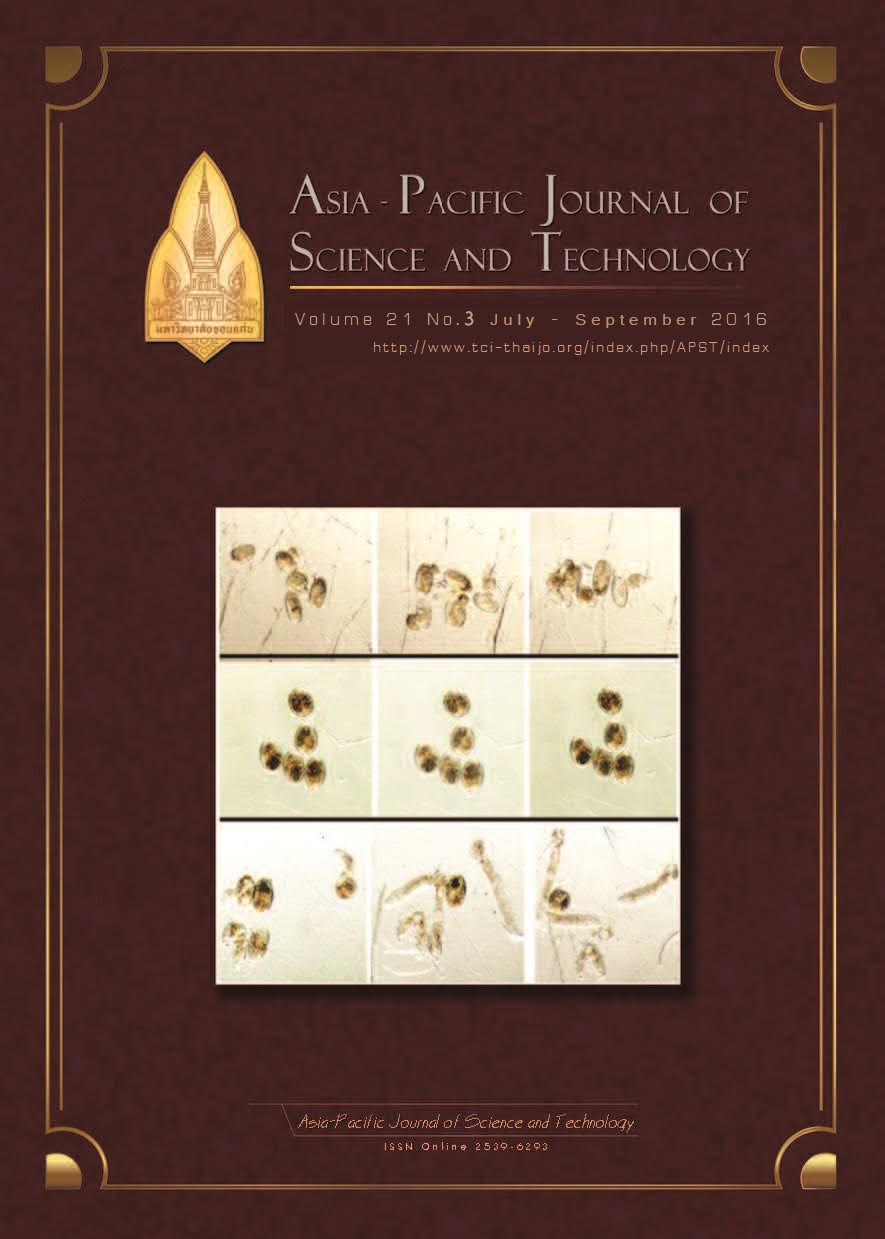Seeking security through rubber intercropping: A case study from northeastern Thailand
Main Article Content
Abstract
A major constraint of smallholder farmer to plant their rubber is the sources of income for their subsistence during 6-7 years from planting until the rubber enter production. Again, it was due to price fluctuations year to year after enter production. Intercropping of rubber with cash crops will provide alternative sources of income and protect farmers from price instability. This qualitative research using household rubber growers interviews, crop and soil measurement were carried out to study aim to investigate growth of rubber and cash crops, yield of cash crops, as well as farmers’ income from cash crops at Nongnangvong village, Khon Kaen province where farmers practiced intercropping of immature rubber with banana and cassava, and at Poopankham village, Nongbualampoo province, as well as Nongsaengsoi village, Udorn-Tani province where farmers practiced intercropping of mature rubber with coffee. The results indicated that intercropping of immature rubber with banana and banana combined with Calopogonium caeruleum tends to promote girth growth. Cassava intercropped with immature rubber gave similar girth growth of rubber compared to sole rubber. Mature rubber trees intercropped with coffee had no retarding effect on the main crop. In some cases, intercropping of mature rubber with coffee tended to improve girth growth of rubber trees compared to sole rubber. Intercropping of banana and banana combined with Calopogonium caeruleum with immature rubber provided net income 139 and 148 US$/ha, respectively. Cassava intercropped with immature rubber gave net income 763 US$ha-1 in this present study. Irrespective of coffee, intercropping coffee with mature rubber provided net income 310-845 US$ha-1 in this study. Therefore, intercropping immature or mature rubber with economic crops would provide assurance of securing rubber grower under price fluctuation.
Article Details
References
(1) Laosuwan P. Intercropping of young rubber. Suranaree J. Sci. Technol. 1996; 3: 171-179.
(2) Rodrigo VHL, Stirling CM, Naranpanawa RMAKB, Herath PHMU. Intercropping of immature rubber present status in Sri Lanka and financial analysis of rubber intercropped planted with three densities of banana. Agroforest. Syst. 2001; 51: 35-48.
(3) Rodrigo VHL, Stirling CM, Silva TUK, Pathirana PD. The growth and yield of rubber at maturity is improved by intercropping with banana during the early stage of rubber cultivation. Field Crop. Res. 2005; 91: 23-33.
(4) Rice Department and Rubber Department. Upland rice varieties recommended for intercropping between rows of rubber in the South of Thailand in 1978. Para Rubber Journal. 1978. 1(1): 5-11. Thai.
(5) Laosuwan P. Yield potential of soybean in the south of Thailand: FNR Research Report for 1985. 1985.
(6) Laosuwan P. Yeedum I, Sripana P, Sirisongkram P, Thongsomsri A. A study on intercropping of young rubber. Research Report, Faculty of Natural Resource, Prince of Songkla University. 1987. 46 p. Thai.
(7) Laosuwan P, Yeedum I, Sripana P, Sirisongkram P. A study on intercropping of young rubber I. Yield potential of different intercrops. Thai J. Agric. Sci. 1988; 21: 179-188.
(8) Walkley A, Black IA. An examination of degtjareff method for determining soil organic matter and a proposed modification of the chromic acid tritation method. Soil Sci. 1934; 37: 29-37.
(9) Bremner JM. Total nitrogen. In : Methods of soil analysis part 2 : Chemical and microbiological properties. Amer. Soc. Agron. Madison, Wisconsin. 1965; 1149-1178.
(10) Bray RH, Kurtz LT. Determination of total organic and available forms of phosphorus in soil. Soil Sci. 1945; 59: 39-45.
(11) Mckeague JA. Manual on soil sampling and methods of analysis. Canadian Society of Soil Science. Ottawa, Canada. 1978. 212 p.
(12) National Agriculture and Forestry Research Institute (NAFRI). Intercropping with rubber for risk management. In: Improving livelihoods in the uplands of the Lao PDR, Volum2. National Agriculture and Forestry Research Institute, Vientian, Lao PDR. 2005. 206 p.
(13) Tai EA. Banana. In : Ecophysiology of Tropical Crops, (Alvim, P.T. and Kozlowski, T.T., eds.). Academic Press, Inc. 111 Fifth Aenue, New York. 1977; 441-460.
(14) Akkasaeng C, vorasoot N, Jogloy S, Patanotai A. Relationship between. SPAD readings and chlorophyll contents in leaves of peanut. Thai J. Agric. Sci. 2003; 36(3): 279-284.
(15) Arunyanark A, Jogloy S, Akkasaen C, Vorasoot N, Kesmala T, Nageswararao RC, Wright GC, Patanothai A. Cholorophyll stability is an indicator of drought tolerance in peanut. J. Agron. Crop Sci. 2008; 194: 113-125.
(16) Richardson AD, Duigan SP, Berlyn GP. An evaluation of noninvasive methods to estimate foliar chlorophyll content. New Phytol. 2002; 153: 185-194.
(17) Bote AD, Struik PC. Effect of shade on growth, production and quality of coffee (Coffee araboca) in Ethiopia. J. Hortic. For. 2011; 3(11): 336-341.
(18) Bartlett GA, Remphrey WR. The effect of reduced quantities of photosynthetically active radiation on Fraxinus pennsylvanica growth and architecture. Can. J. Bot. 1998; 76: 1359-1365.
(19) Rubber Research Institute of Thailand (RRIT). Caeruleum (Calopogonium caeruleum) cover legume intercropped with rubber and seed production. Agricultural Co-operative group publication, Jatuchack, Bangkok. 2013. 35 p. Thai.
(20) Nugawela A. Gas exchange characteristic of Hevea Genotypes and their use in selection for crop yield. (Ph.D. Thesis). University of Essex, U.K. 1989.
(21) Senevirathna AMWK. The influence of farmer knowledge, shade and planting density on Small-holder rubber/banana intercropping in Sri Lanka. (Ph.D. Thesis). School of Agriculture and Forest Sciences, University of Wales, Bangor, U.K. 2001.
(22) Polthanee A, Promsena K. Effect of cropping systems in intercropping with rubber on rubber growth and economic return. J. Sci. Technol. 2010; 29(3): 282-289. Thai.
(23) Baliza DP, Cunha RL, Guimaraes RJ, Barbosa PRAD, Avila FW, Passos AMA. Physiological characteristics and development of coffee plants under different shading levels. Rev. Bras. Cienc. Agr. 2012; 7(1): 37-43.
(24) Soto-Pinto L, Perfecto I, Castillo-Hermandez,J, Caballero-Nieto J. Shade effect on coffee production at the northern Tzeltal zone of the state of Chiapas, Mexico. Agric. Ecosyst. Environ. 2000; 80: 61-69.


